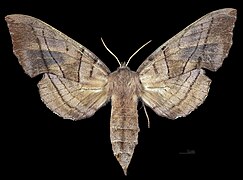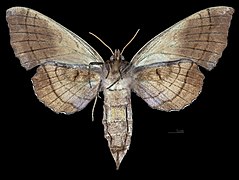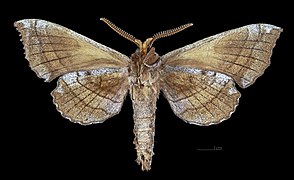Amorpha juglandis
| Walnut sphinx | |
|---|---|

| |
| Scientific classification | |
| Domain: | Eukaryota |
| Kingdom: | Animalia |
| Phylum: | Arthropoda |
| Class: | Insecta |
| Order: | Lepidoptera |
| Family: | Sphingidae |
| Tribe: | Smerinthini |
| Genus: | Amorpha J. Hübner, 1809 |
| Species: | A. juglandis
|
| Binomial name | |
| Amorpha juglandis (J. E. Smith, 1797)[1]
| |
| Synonyms | |
| |
Amorpha juglandis, or the walnut sphinx is a type of moth. It is a part of the genus Amorpha which only has one species (which makes it Monotypic). It is in the family of Sphingidae and was noted by Jacob Hübner in 1809. It was first described by James Edward Smith in 1797.
It is native to North America. It is found from the Atlantic Ocean to the Rocky Mountains in Canada and the United States.
Description
[change | change source]The wingspan is 45–75 mm.
-
Female
-
Female underside
-
Male
-
Male underside
Biology
[change | change source]The adult moth is nocturnal.
The caterpillar feeds on alder (Alnus), hickory (Carya), hazelnut (Corylus), beech (Fagus), walnut (Juglans), and hop-hornbeam (Ostrya) species. The caterpillar can make a high-pitched whistles. It comes from spiracles in its abdomen. This will startle the bird which will probably not eat it because of that.[2]
References
[change | change source]- ↑ "CATE Creating a Taxonomic eScience - Sphingidae". Cate-sphingidae.org. Retrieved 2011-11-01.[permanent dead link]
- ↑ Fullard, James H.; Napoleone, Nadia (2001). "Diel flight periodicity and the evolution of auditory defences in the Macrolepidoptera". Animal Behaviour. 62 (2): 349. doi:10.1006/anbe.2001.1753. S2CID 53182157.
Further reading
[change | change source]- Bura, V. L.; Rohwer, V. G.; Martin, P. R.; Yack, J. E. (2010). "Whistling in caterpillars (Amorpha juglandis, Bombycoidea): Sound-producing mechanism and function". Journal of Experimental Biology. 214 (Pt 1): 30–7. doi:10.1242/jeb.046805. PMID 21147966.
- Knight, K. (2010). "Whistling Caterpillars Startle Birds". Journal of Experimental Biology. 214 (Pt 14): ii. doi:10.1242/jeb.054155. PMID 21834205.
Other websites
[change | change source]- Lotts, Kelly & Naberhaus, Thomas (2017). "Walnut sphinx Amorpha juglandis (J.E. Smith, 1797)". Butterflies and Moths of North America. Retrieved December 11, 2018.
- "Amorpha juglandis (J. E. Smith, 1797)". Sphingidae of the Americas. Archived June 29, 2006.
- Cotinis (December 19, 2012). "Genus Amorpha". BugGuide. Retrieved December 11, 2018.




